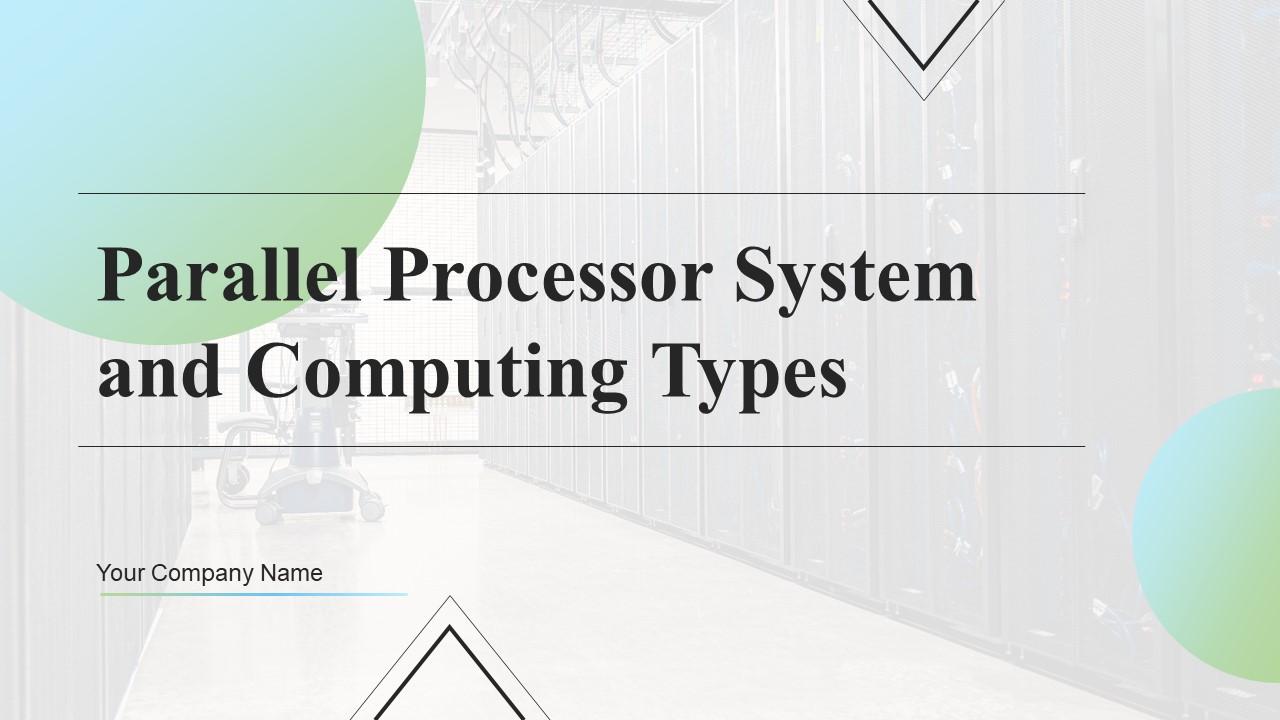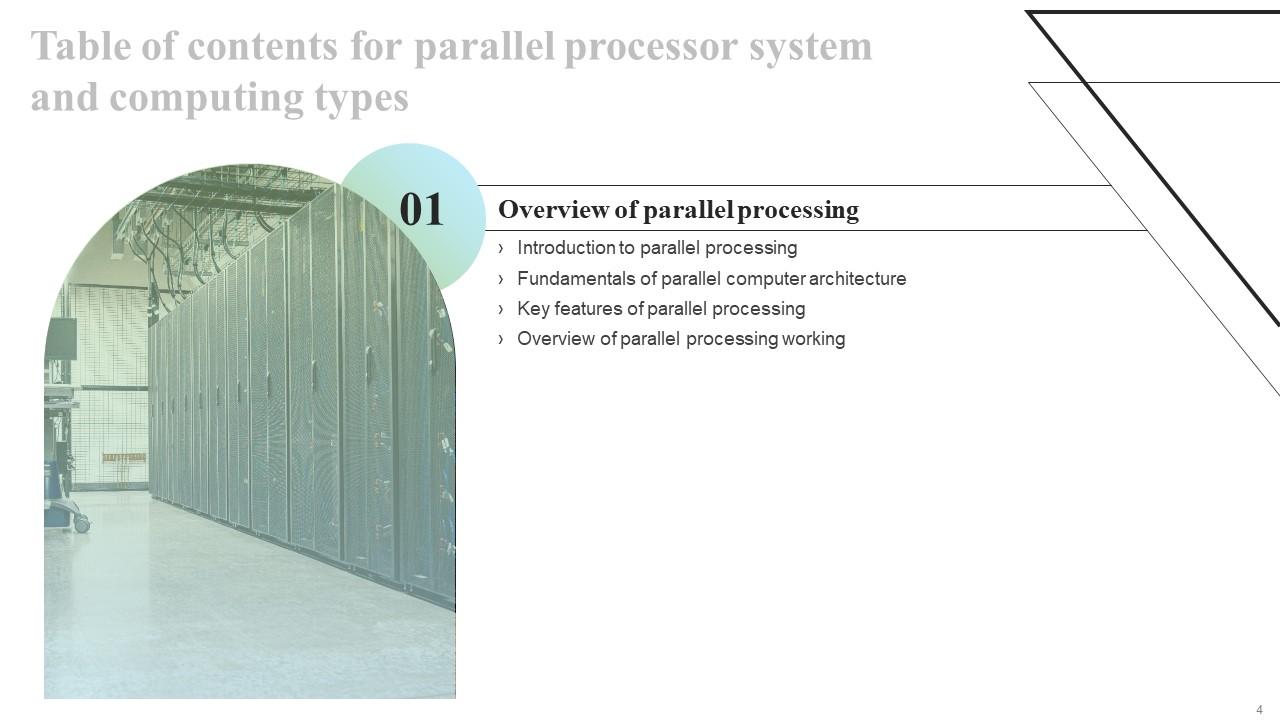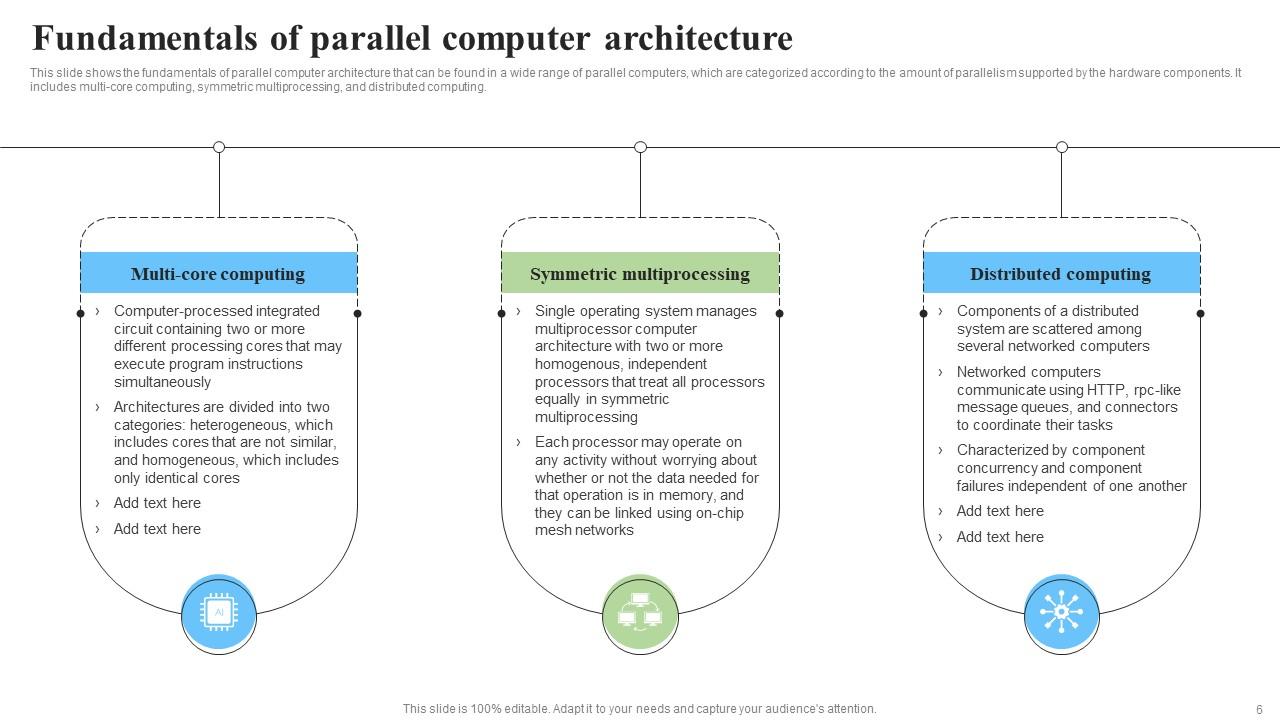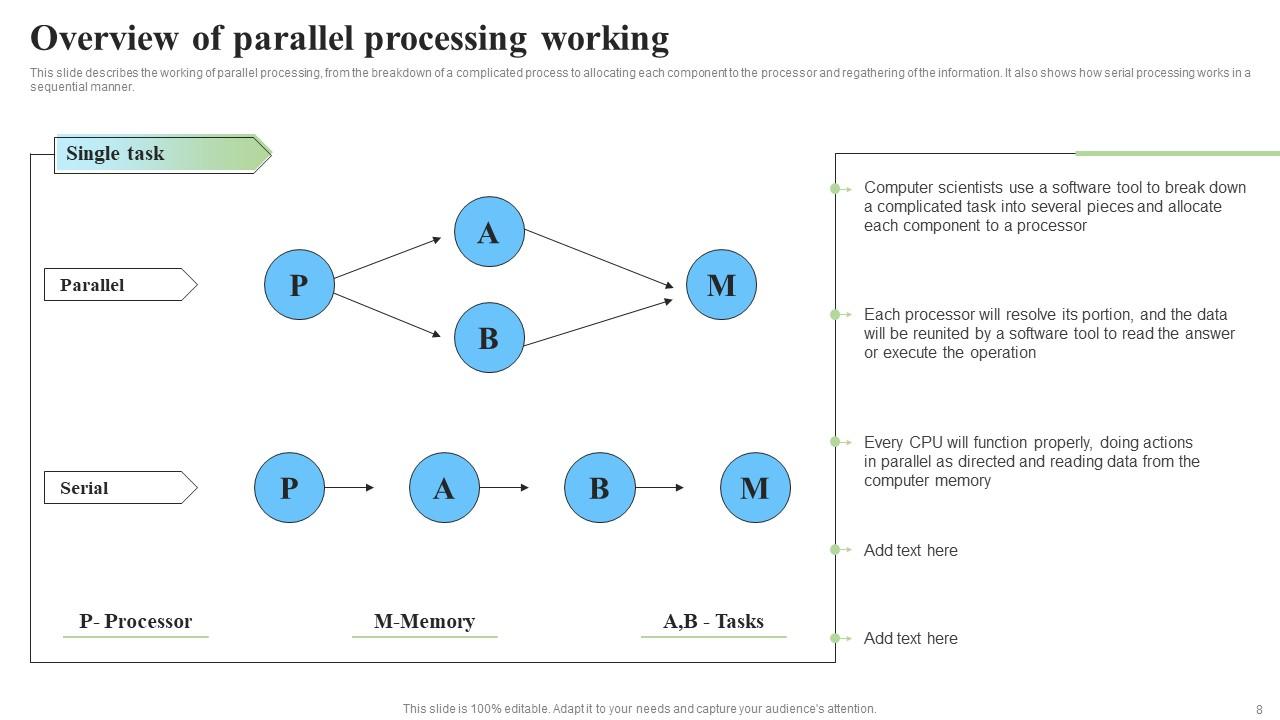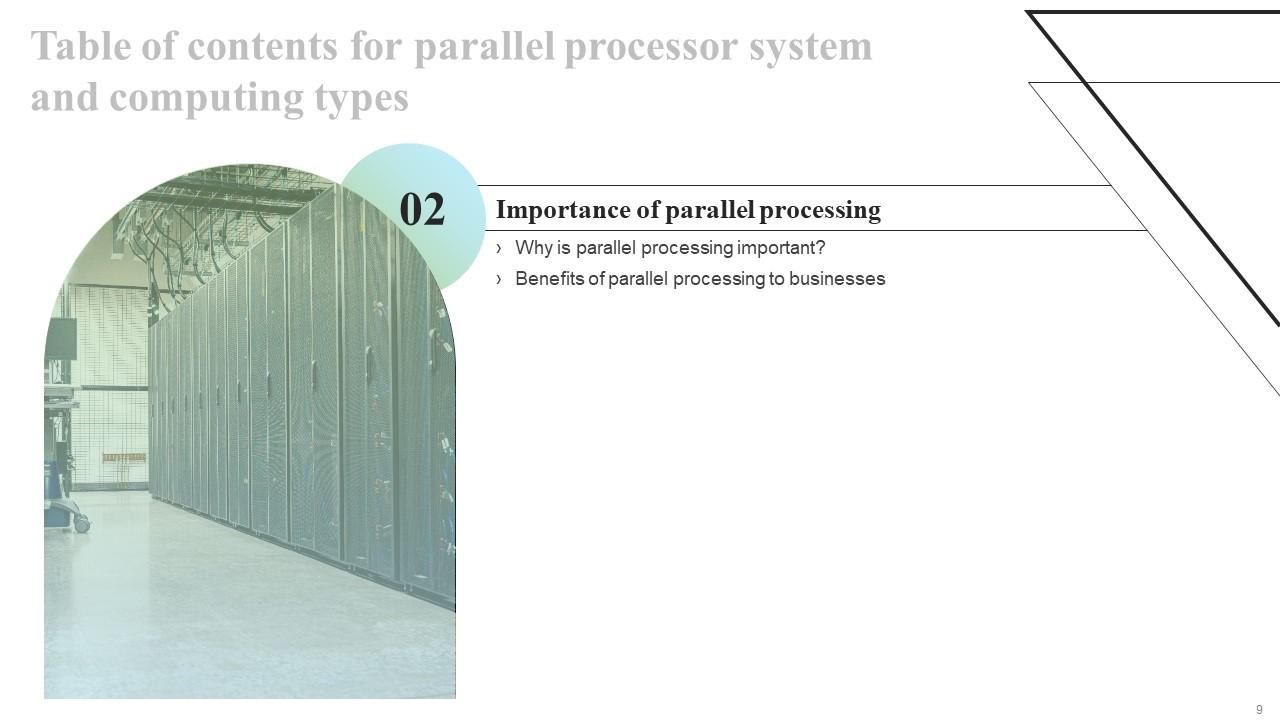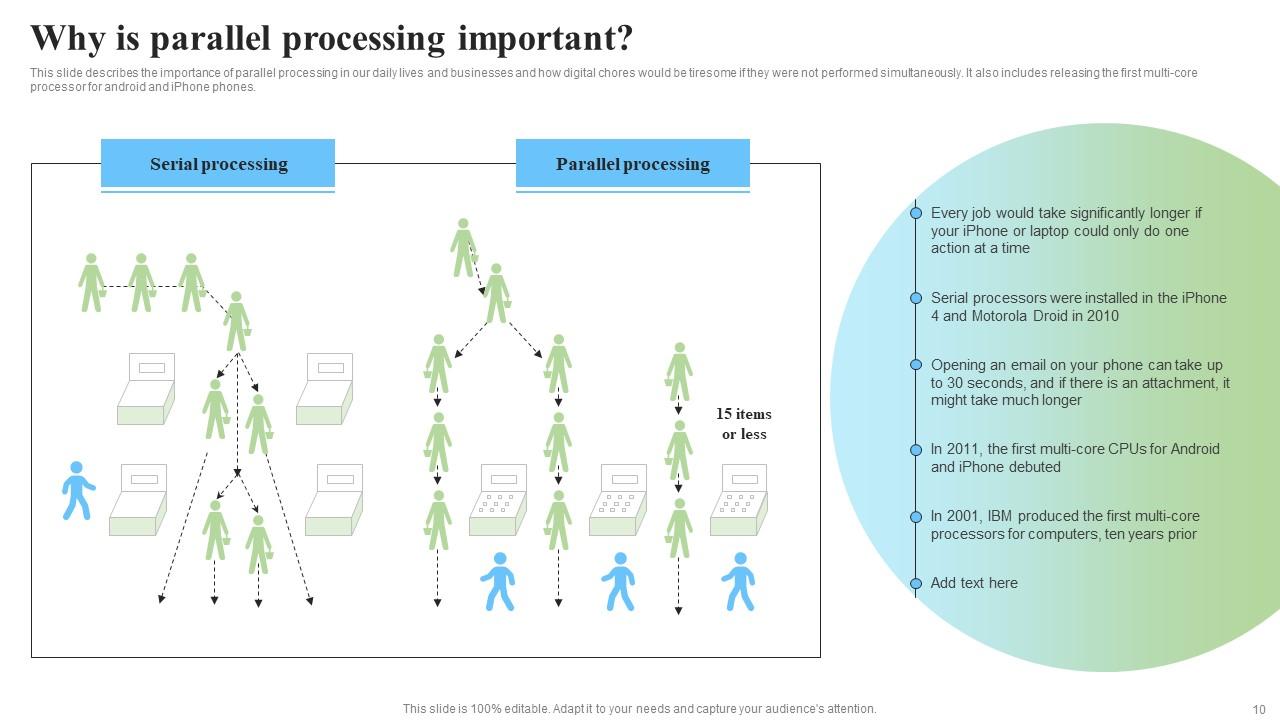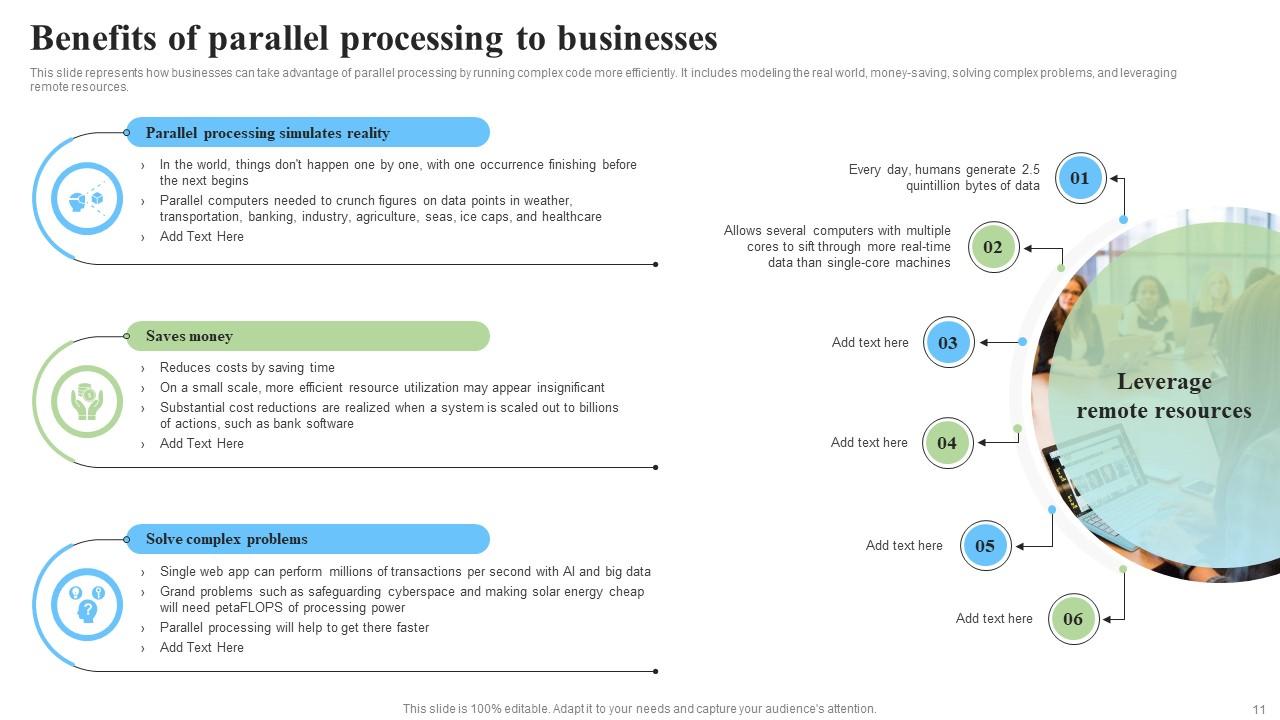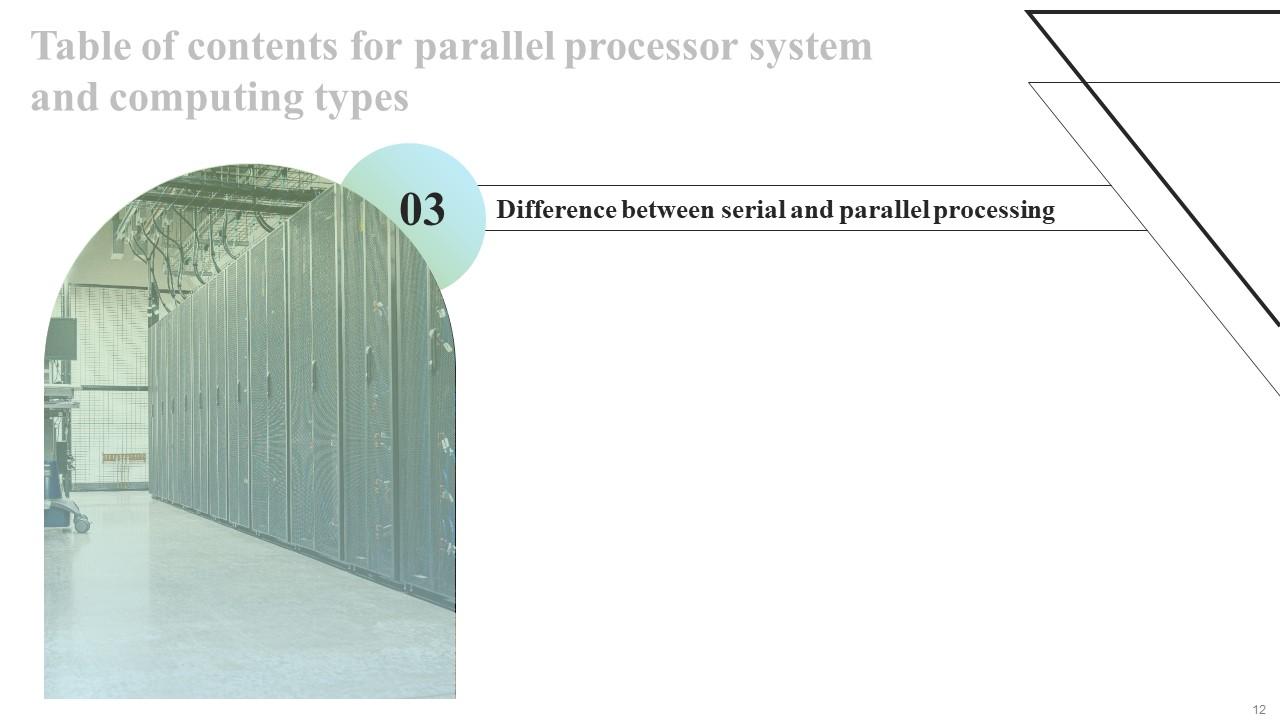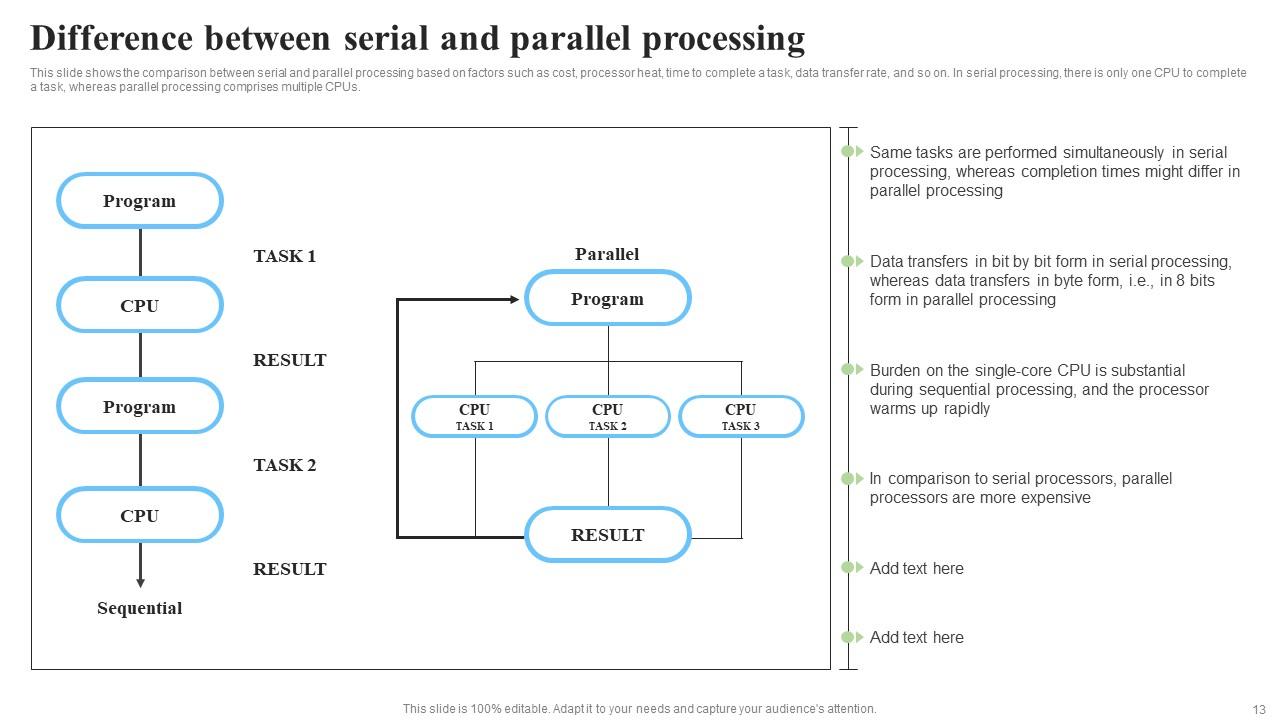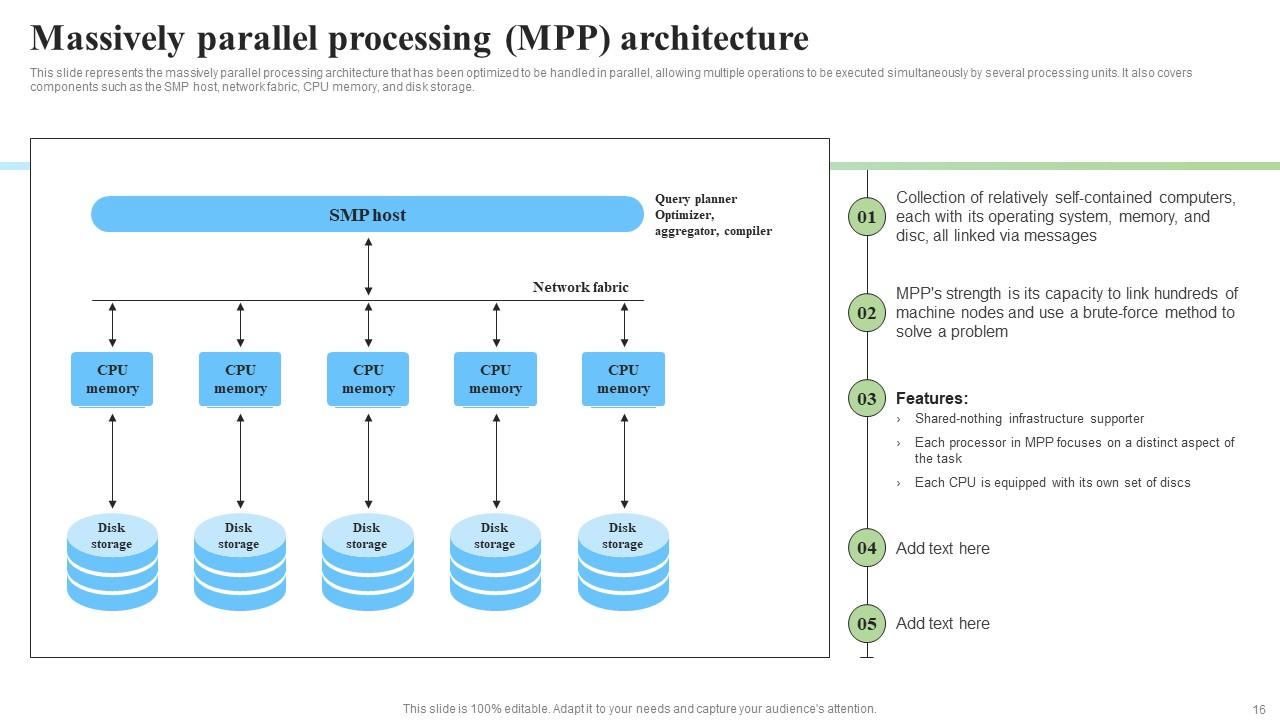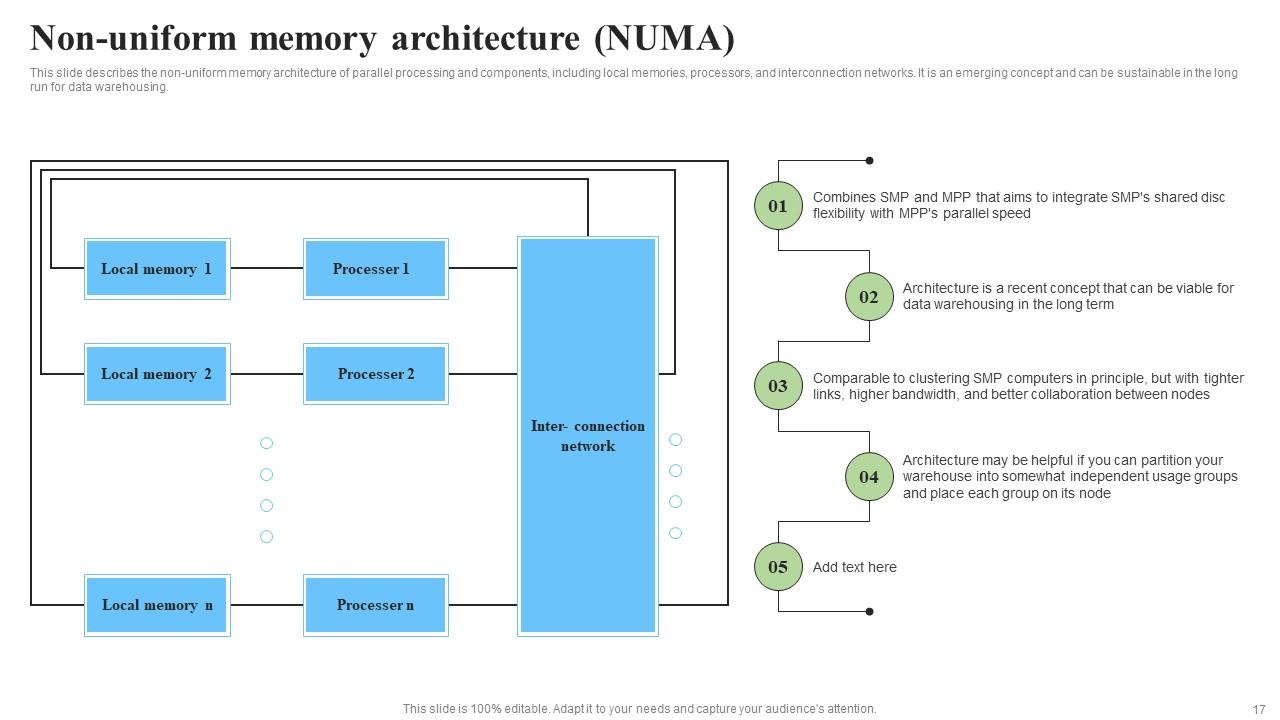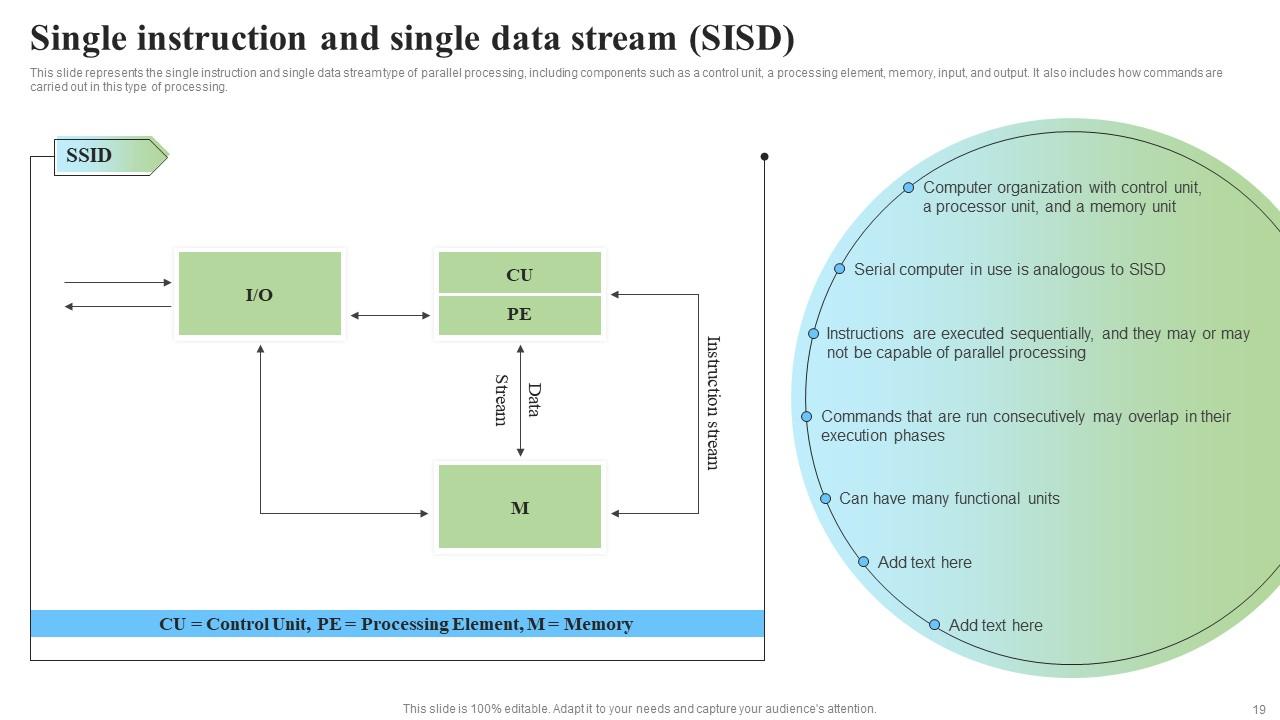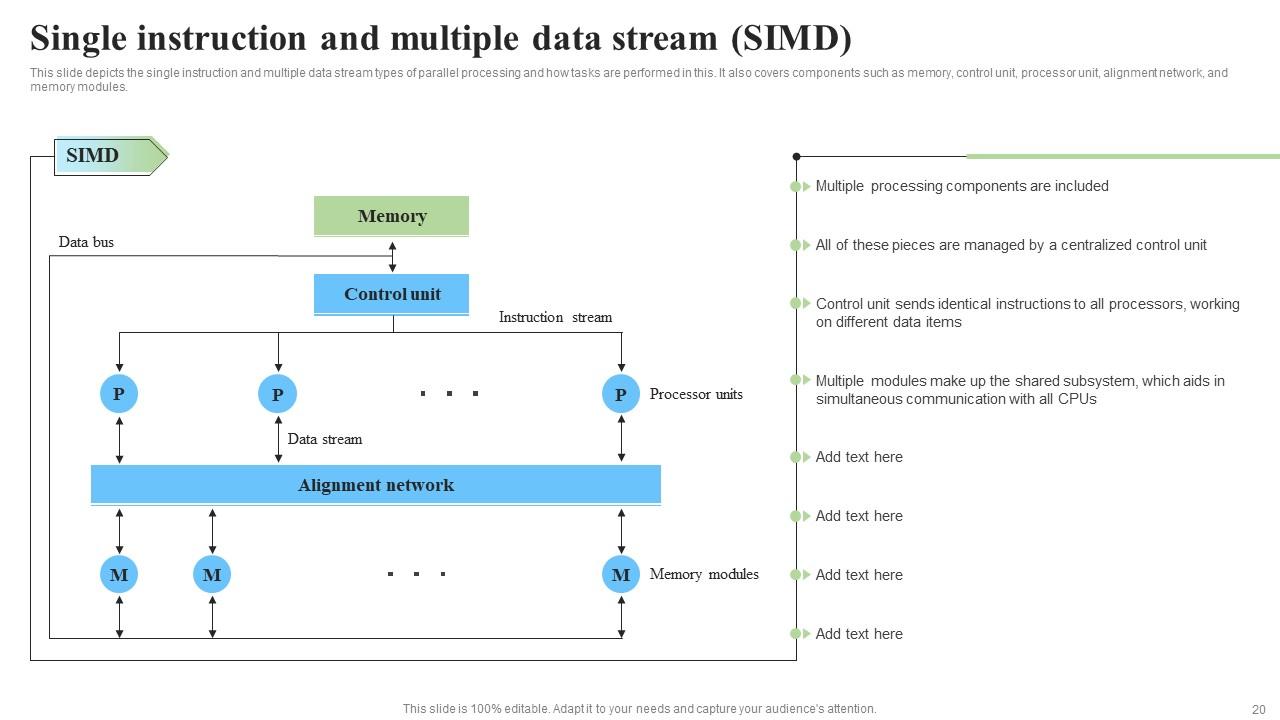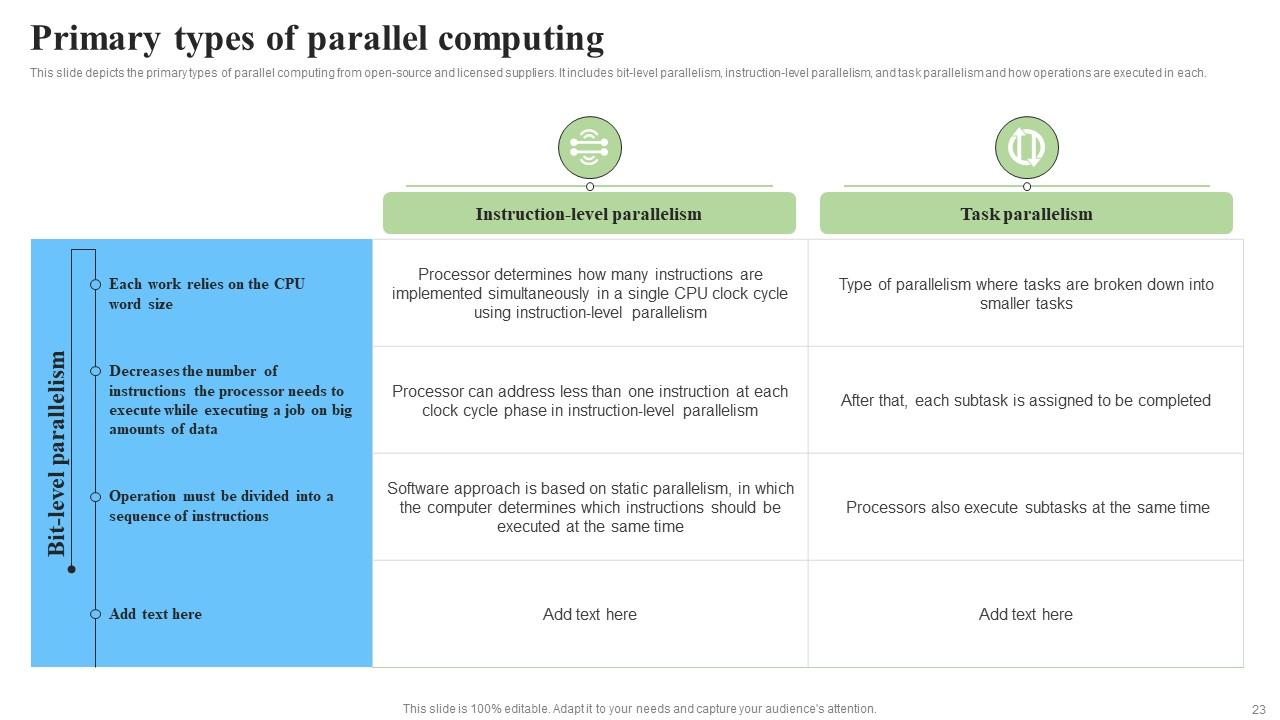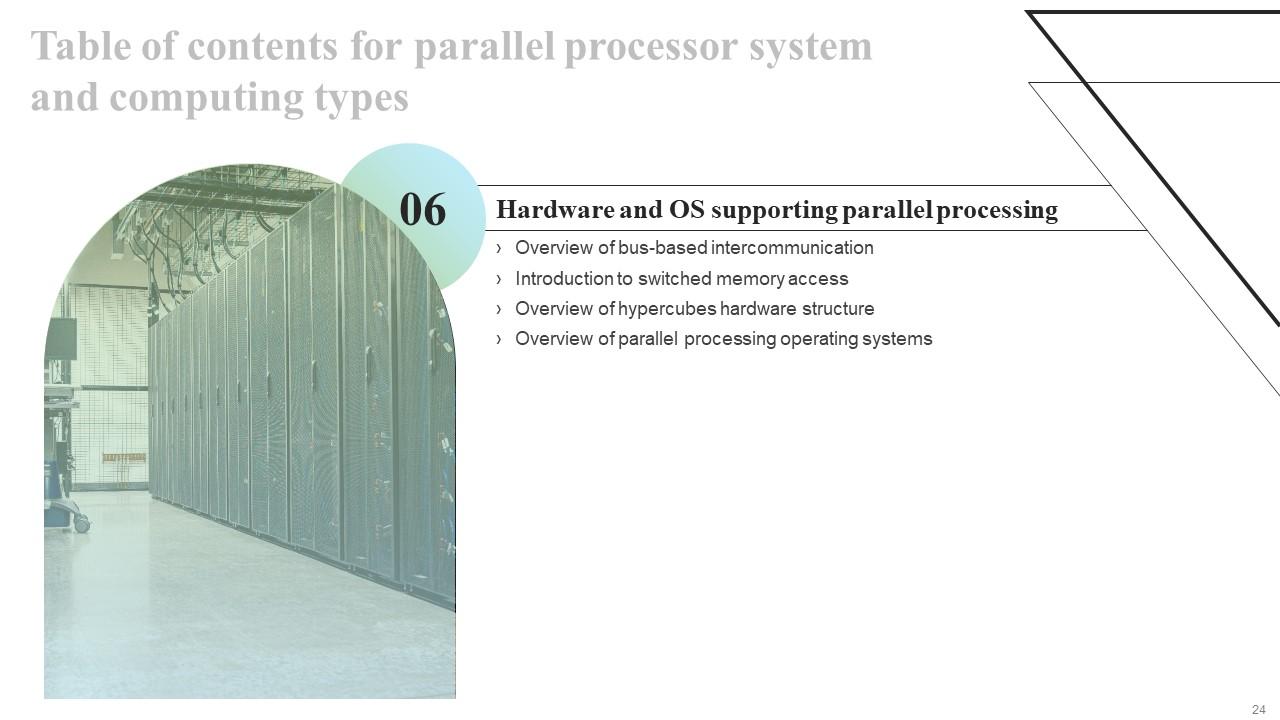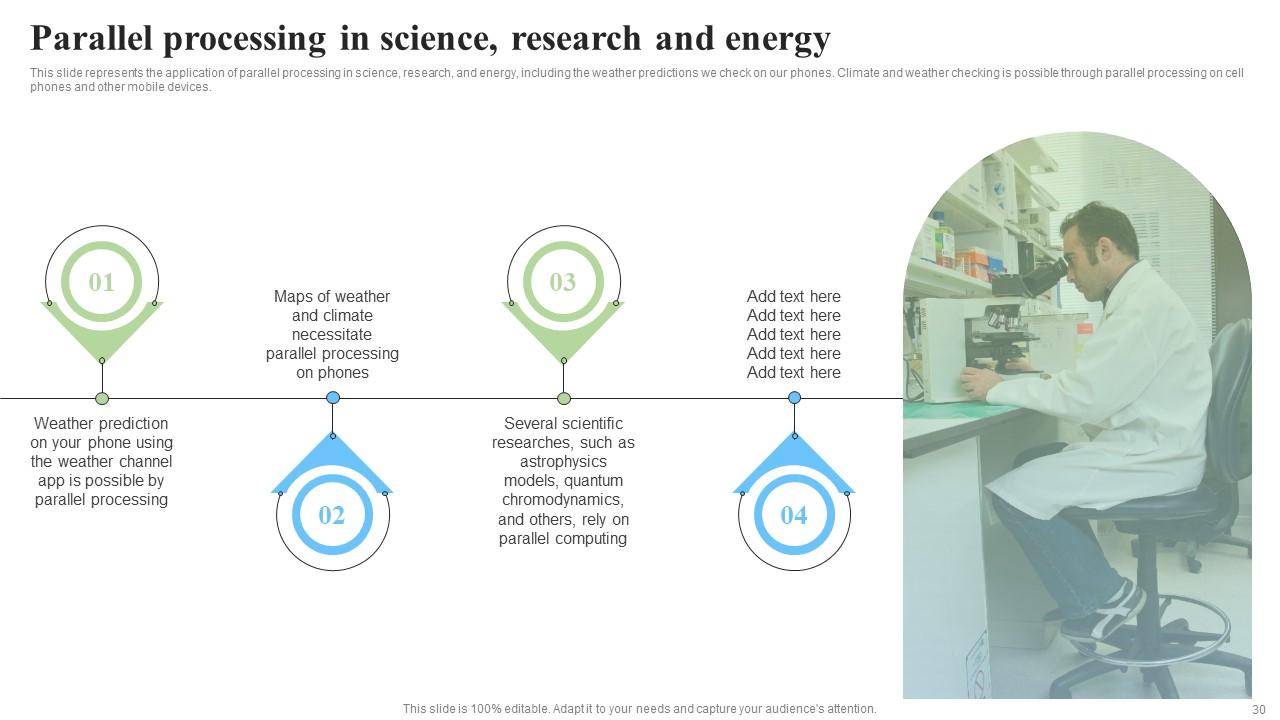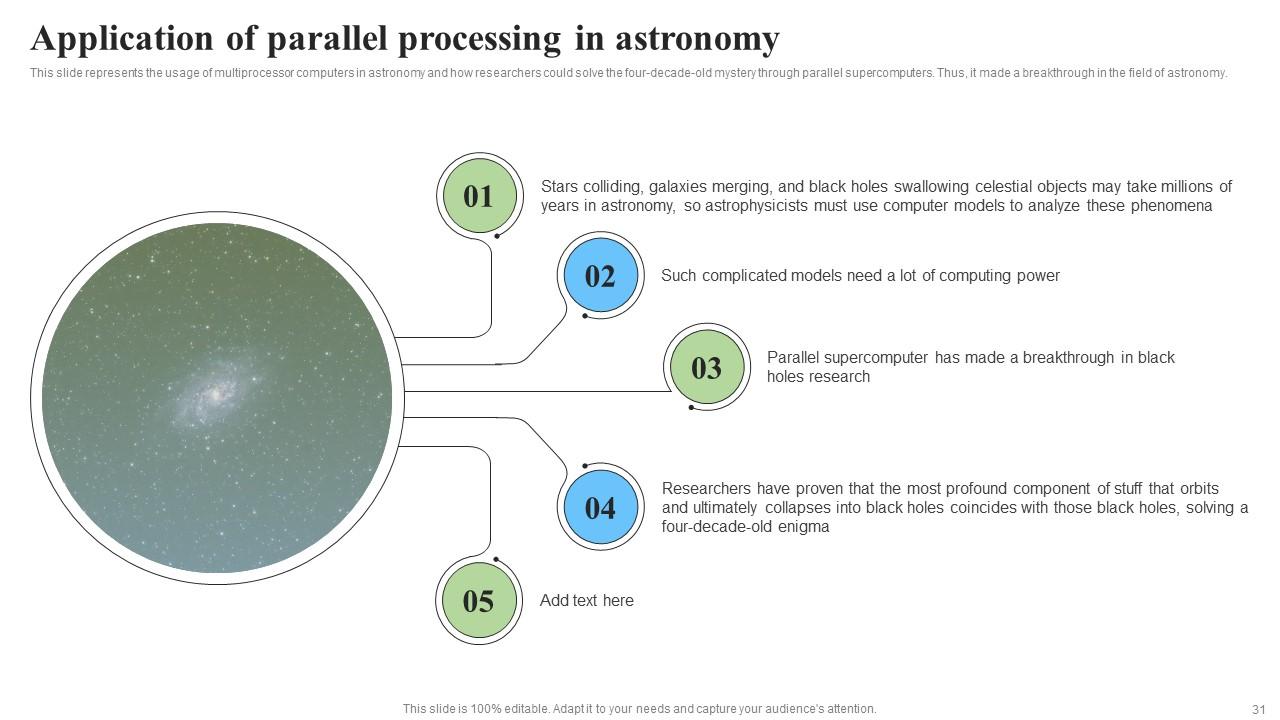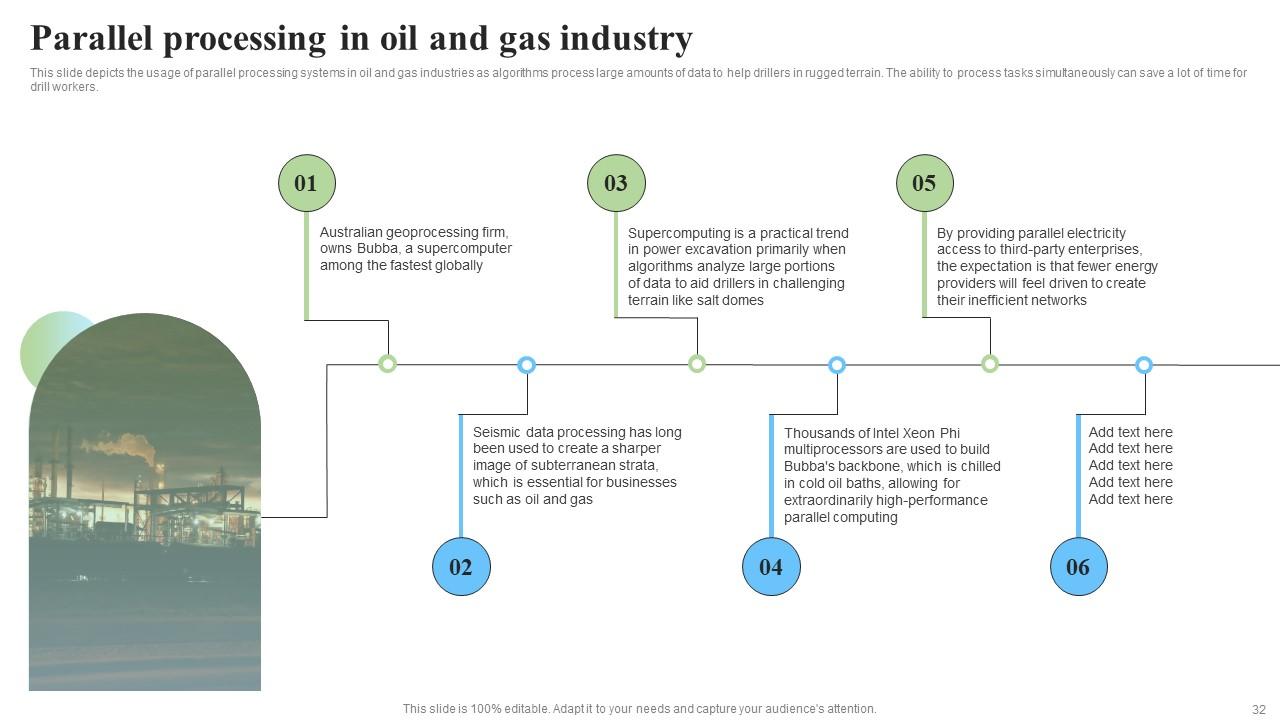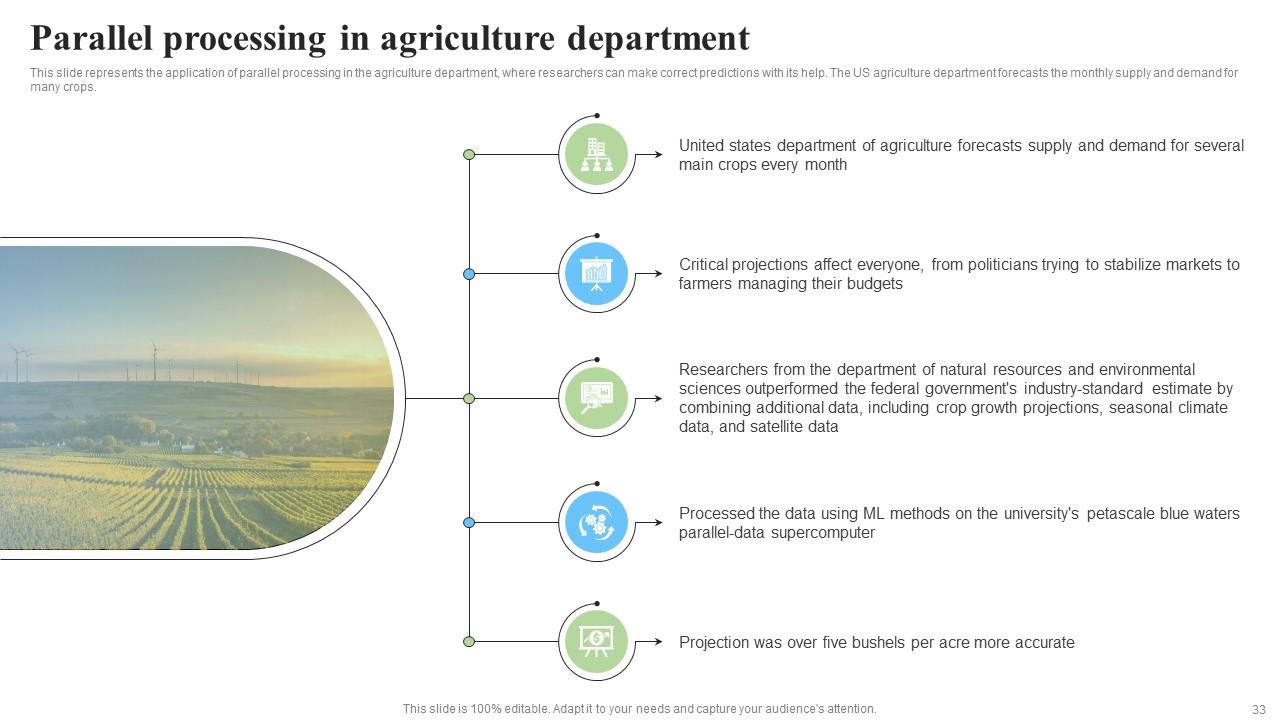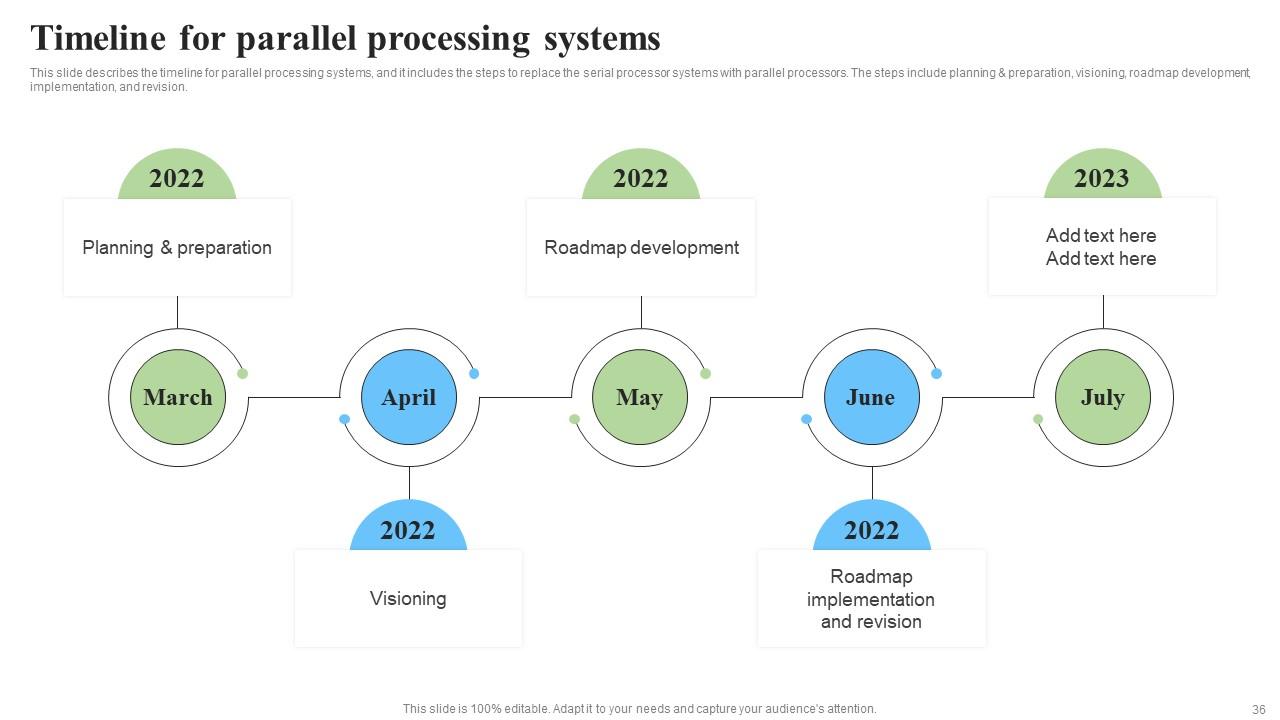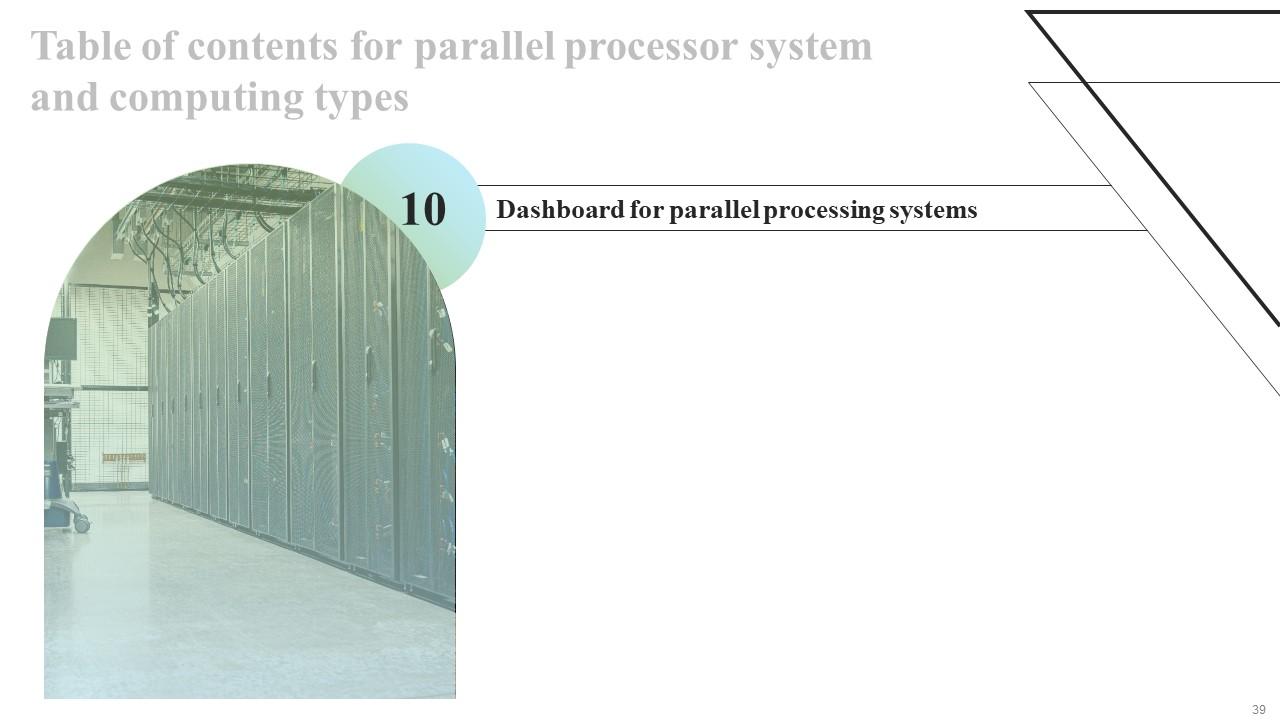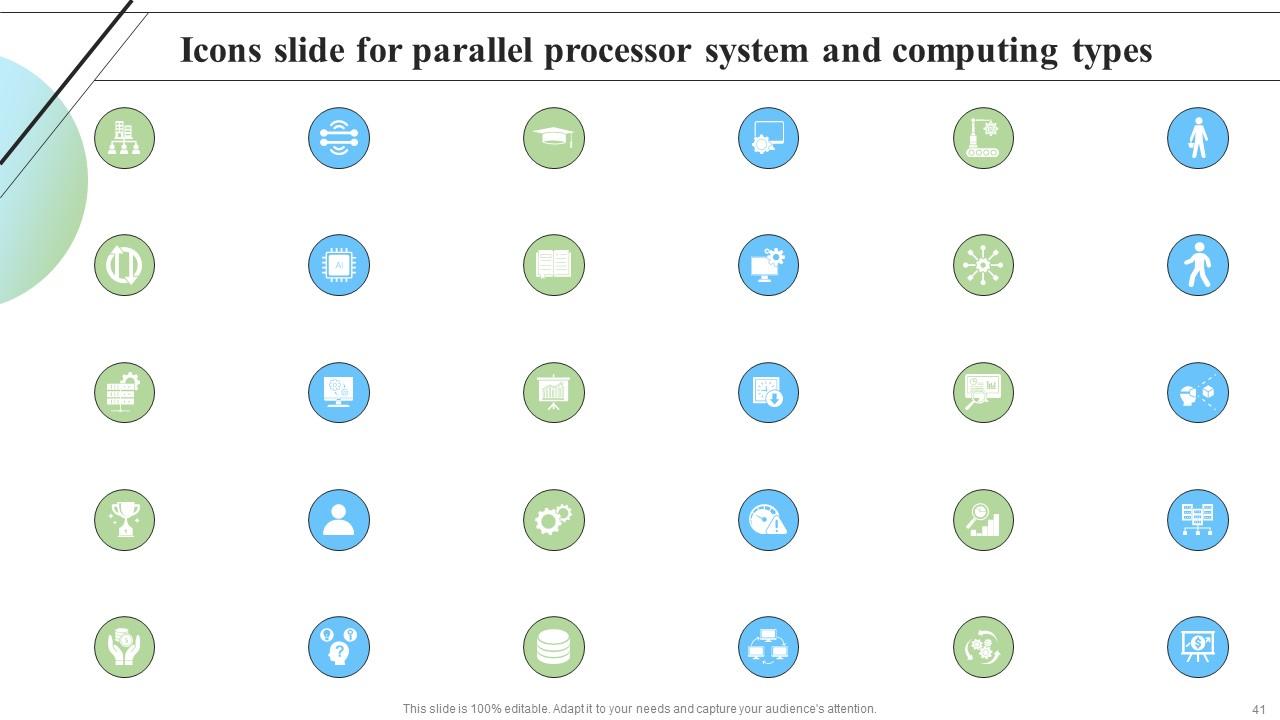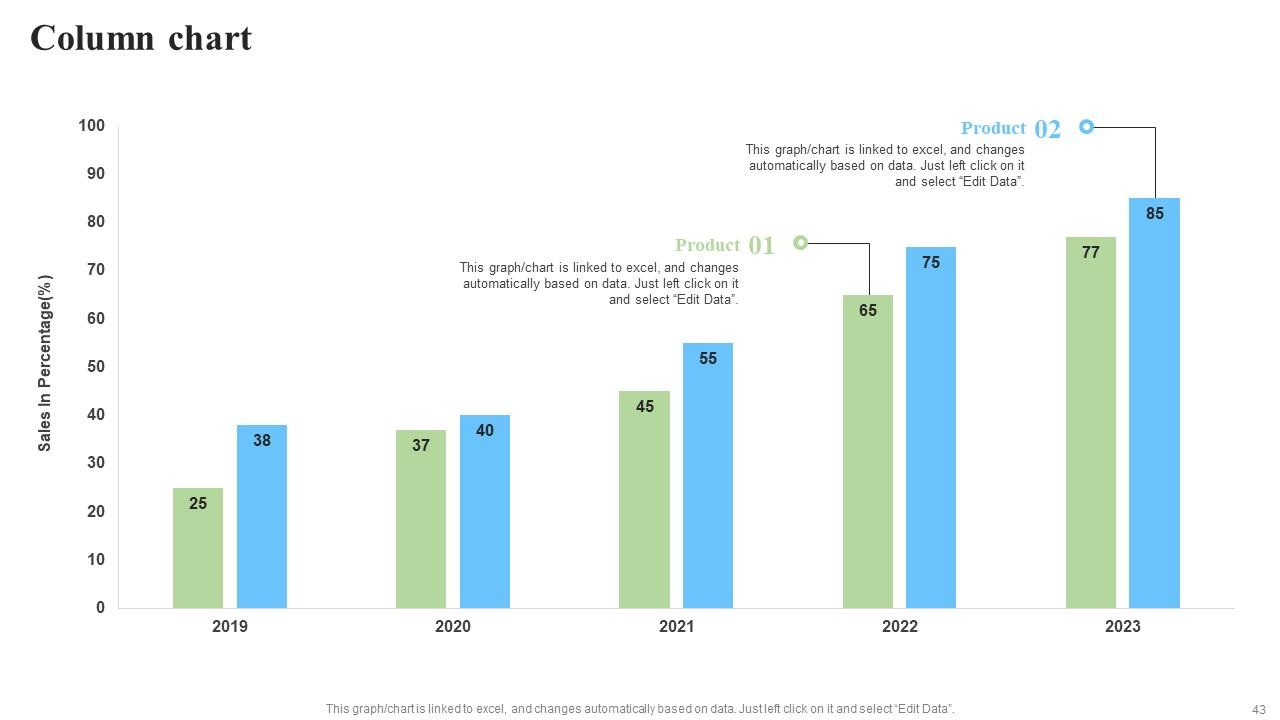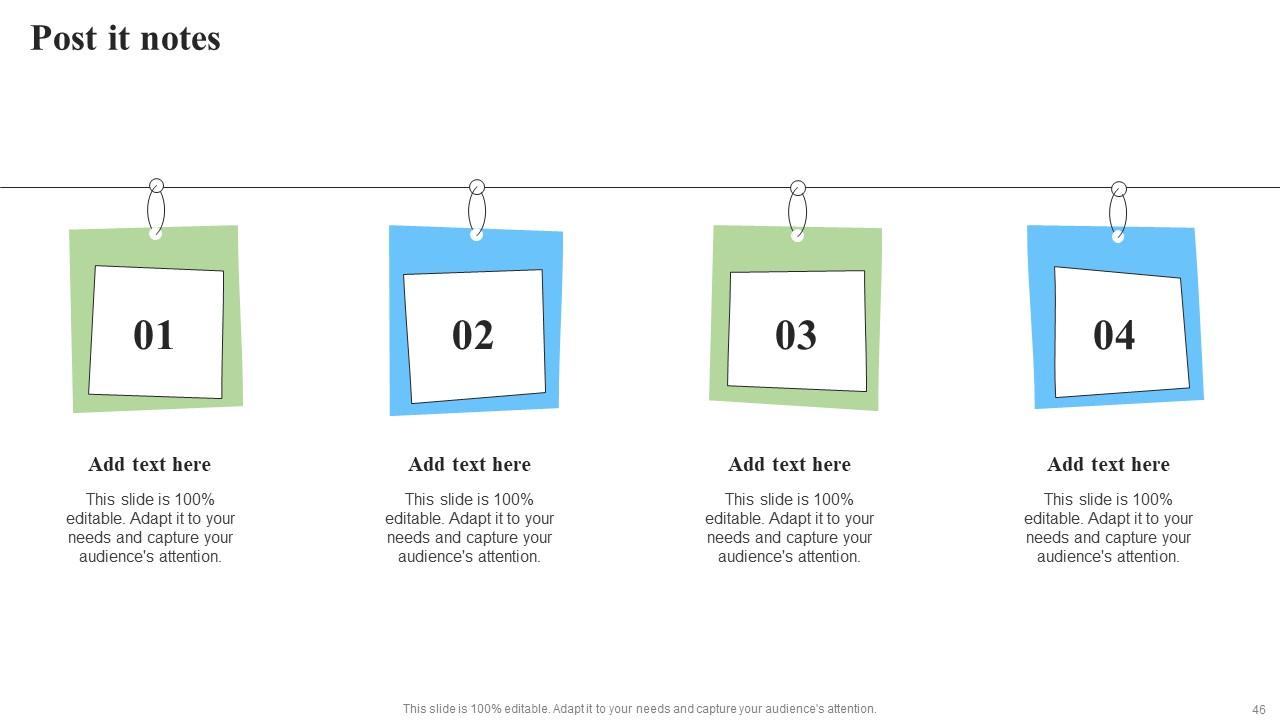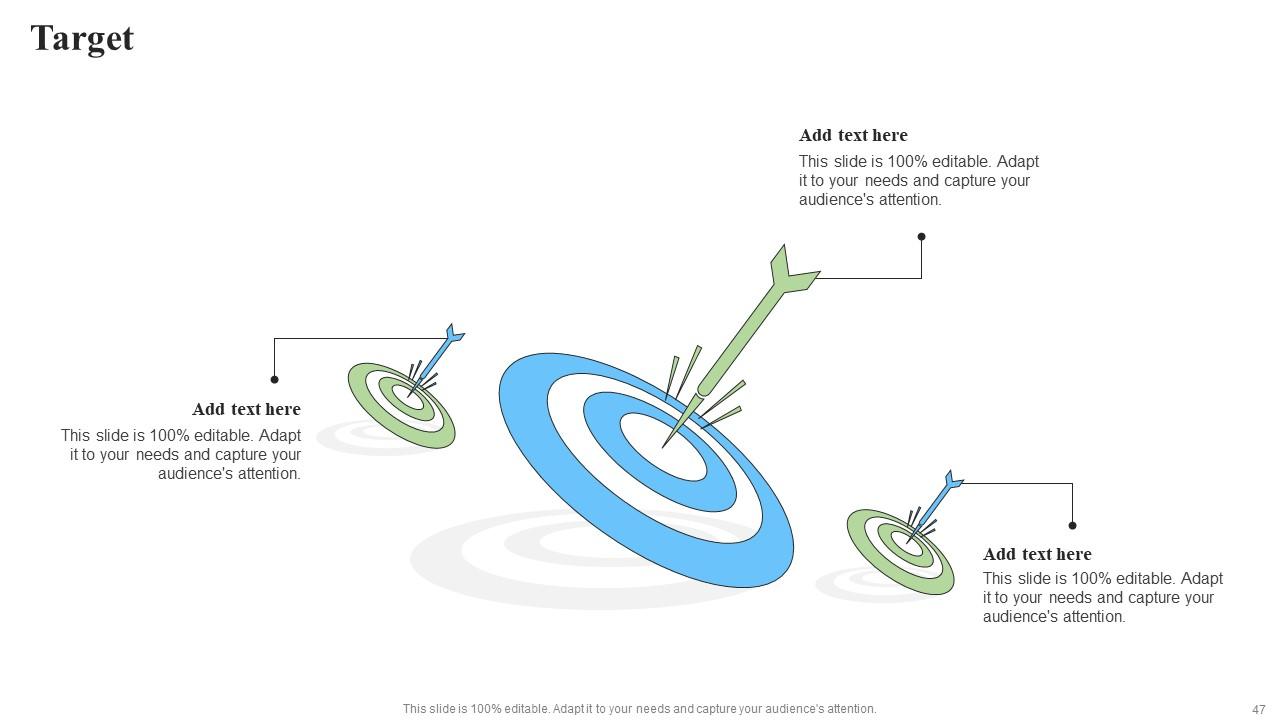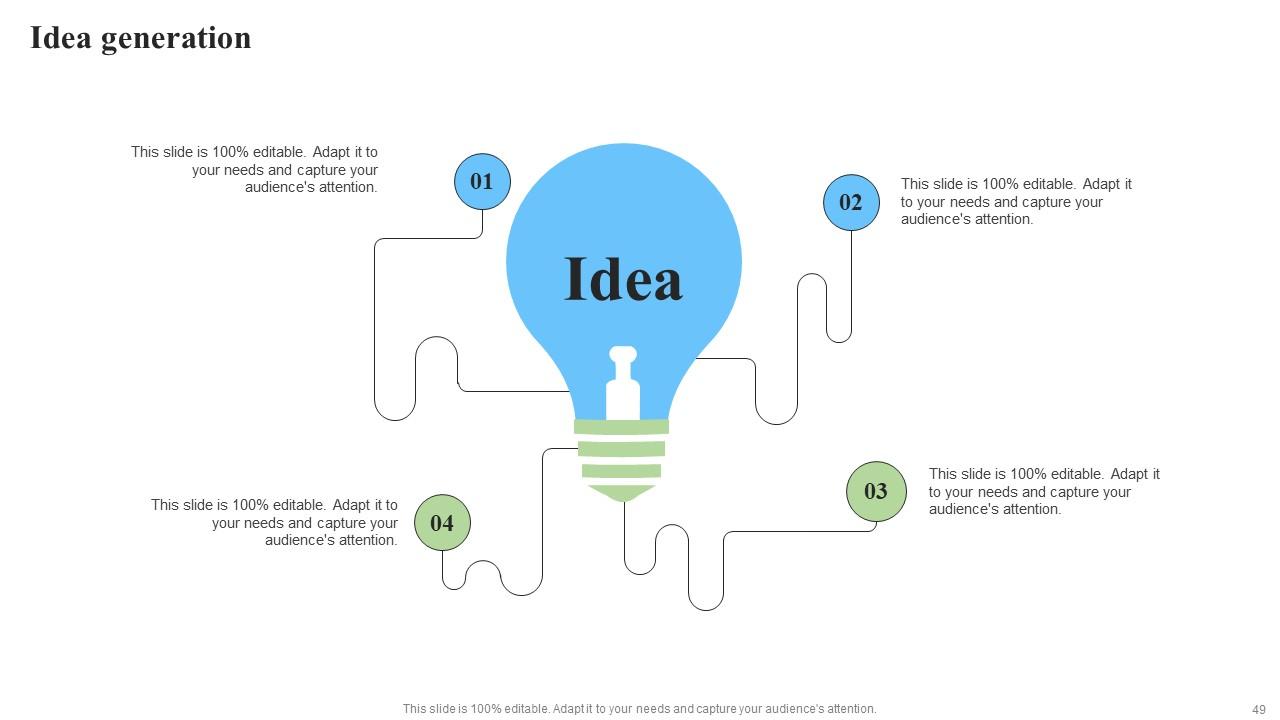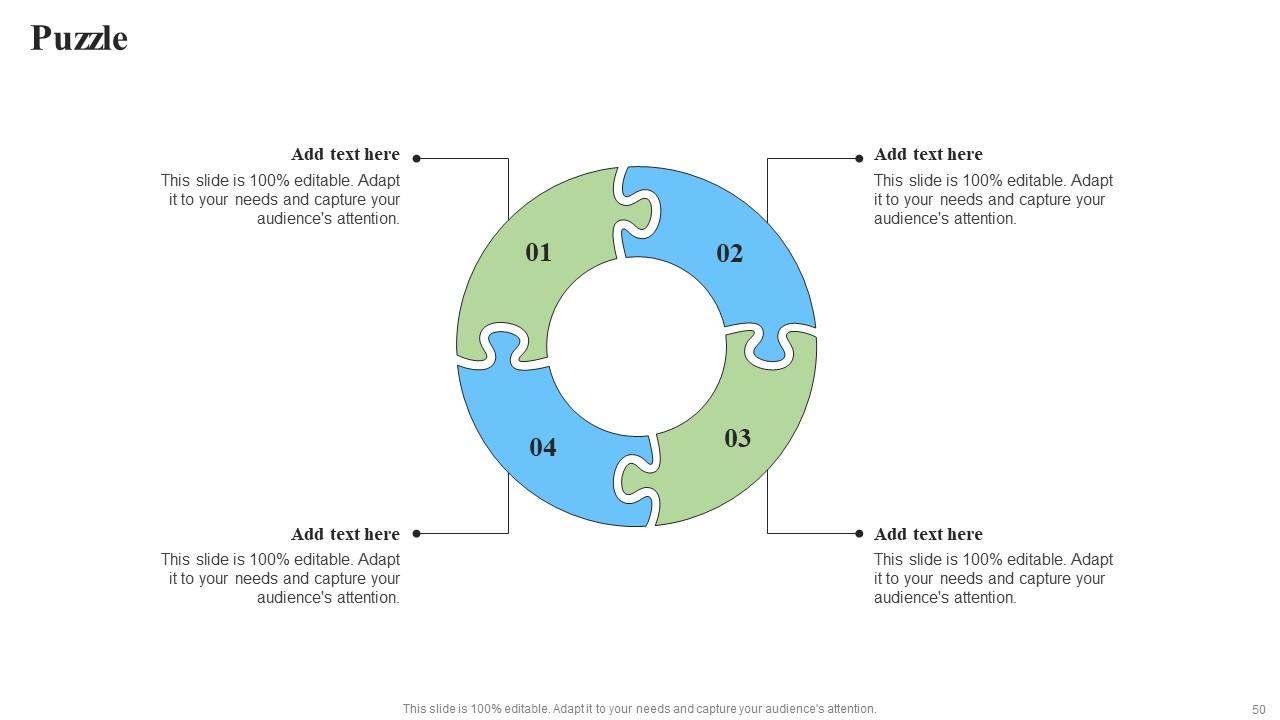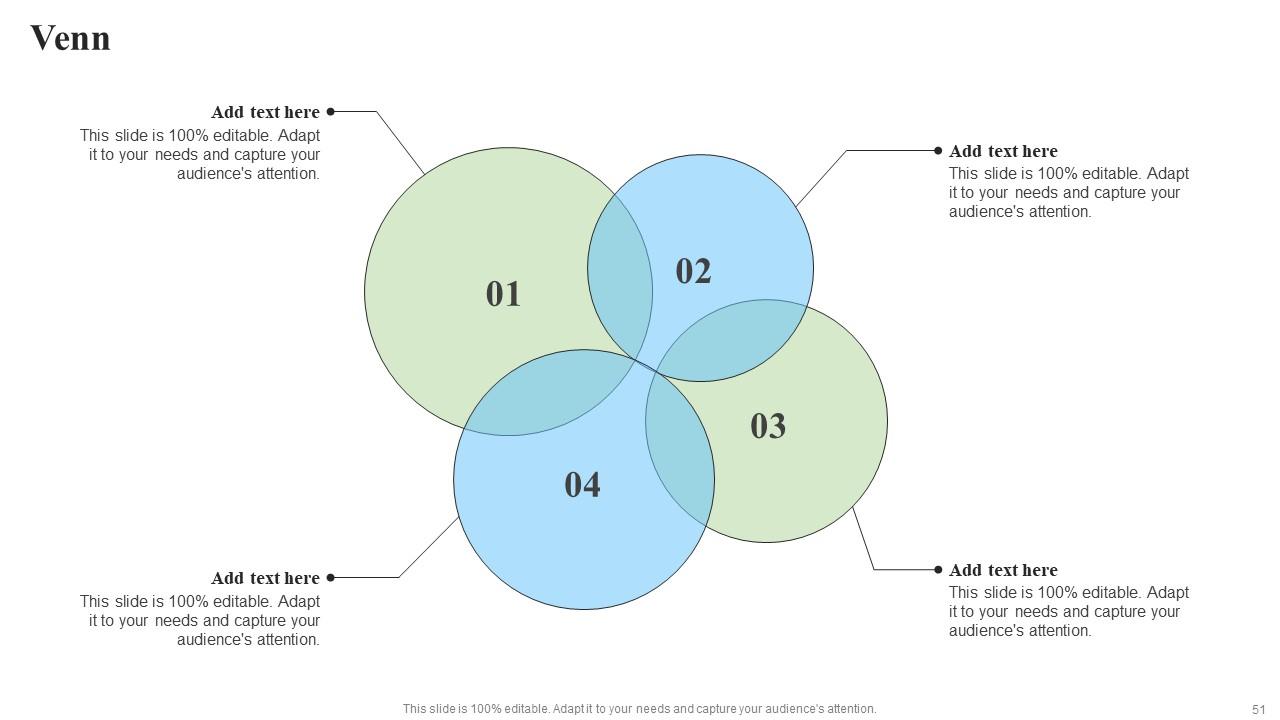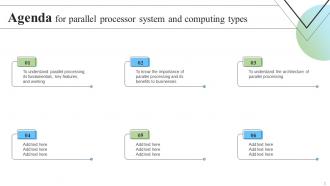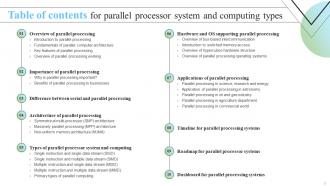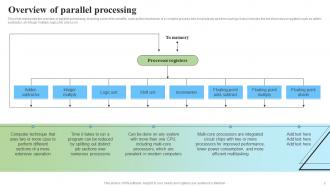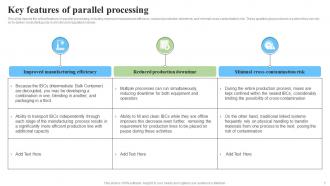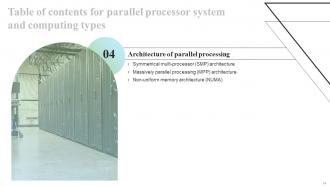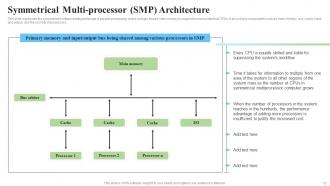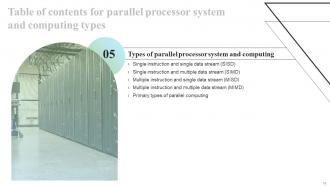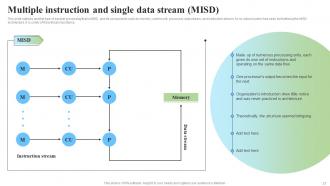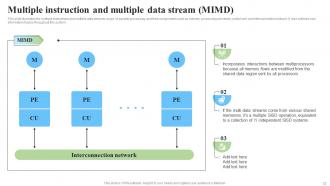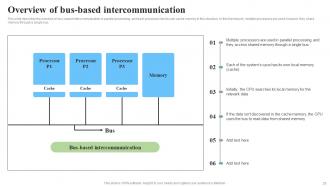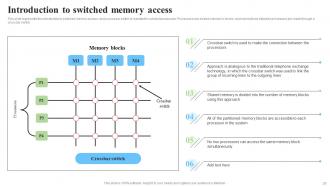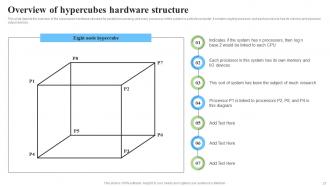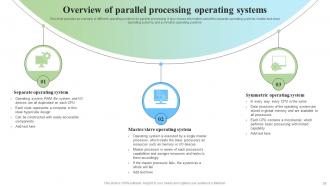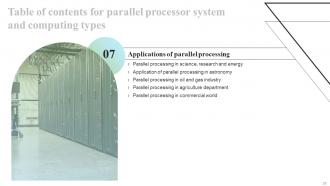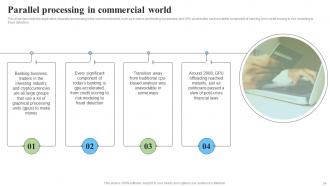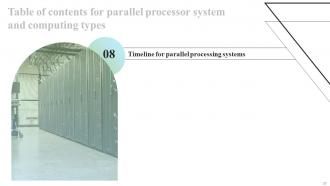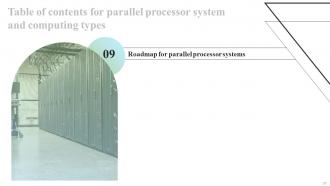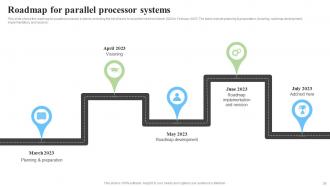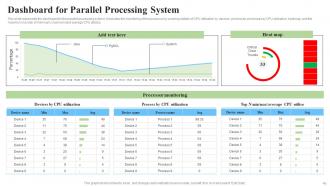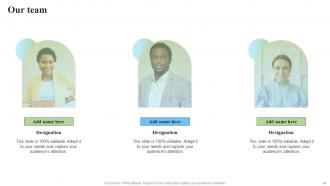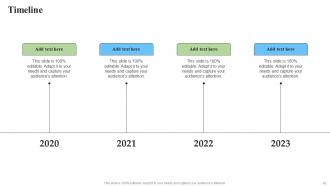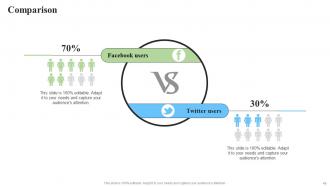Parallel Processor System And Computing Types Powerpoint Presentation Slides
Parallel Processing gives a brief idea about parallel processing, its importance, how it is different from serial processing, its architecture, and various types. In this Parallel Processor System and Computing Types PowerPoint, we have discussed the overview of parallel processing, fundamentals of parallel computer architecture, the importance of parallel processing, and business benefits. In addition, this Parallel Processing PPT contains a section architecture of parallel processing. Furthermore, this Parallel Processing Overview template includes the different types of parallel processing. Moreover, this deck caters to the hardware supporting parallel processing. Lastly, this Parallel Processing deck comprises parallel processing applications in different sectors such as agriculture, science, research, etc. It also includes a timeline, a roadmap, and a dashboard. Download our 100 percent editable and customizable template, which is also compatible with Google Slides.
- Google Slides is a new FREE Presentation software from Google.
- All our content is 100% compatible with Google Slides.
- Just download our designs, and upload them to Google Slides and they will work automatically.
- Amaze your audience with SlideTeam and Google Slides.
-
Want Changes to This PPT Slide? Check out our Presentation Design Services
- WideScreen Aspect ratio is becoming a very popular format. When you download this product, the downloaded ZIP will contain this product in both standard and widescreen format.
-

- Some older products that we have may only be in standard format, but they can easily be converted to widescreen.
- To do this, please open the SlideTeam product in Powerpoint, and go to
- Design ( On the top bar) -> Page Setup -> and select "On-screen Show (16:9)” in the drop down for "Slides Sized for".
- The slide or theme will change to widescreen, and all graphics will adjust automatically. You can similarly convert our content to any other desired screen aspect ratio.
Compatible With Google Slides

Get This In WideScreen
You must be logged in to download this presentation.
PowerPoint presentation slides
This complete deck covers various topics and highlights important concepts. It has PPT slides which cater to your business needs. This complete deck presentation emphasizes Parallel Processor System And Computing Types Powerpoint Presentation Slides and has templates with professional background images and relevant content. This deck consists of total of fifty two slides. Our designers have created customizable templates, keeping your convenience in mind. You can edit the color, text and font size with ease. Not just this, you can also add or delete the content if needed. Get access to this fully editable complete presentation by clicking the download button below.
People who downloaded this PowerPoint presentation also viewed the following :
Content of this Powerpoint Presentation
Slide 1: This slide introduces Parallel Processor System and Computing Types. Begin by stating Your Company Name.
Slide 2: This slide depicts the Agenda of the presentation.
Slide 3: This slide includes the Table of contents.
Slide 4: This slide highlights the Title for the Topics to be covered in the upcoming template.
Slide 5: This slide represents the overview of parallel processing.
Slide 6: This slide shows the fundamentals of parallel computer architecture that can be found in a wide range of parallel computers.
Slide 7: This slide depicts the critical features of parallel processing.
Slide 8: This slide reveals the Overview of parallel processing working.
Slide 9: This slide incorporates the Heading for the Topics to be discussed further.
Slide 10: This slide describes the importance of parallel processing in our daily lives and businesses.
Slide 11: This slide showcases how businesses can take advantage of parallel processing by running complex code more efficiently.
Slide 12: This slide contains the Title for the Ideas to be discussed in the forth-coming template.
Slide 13: This slide shows the comparison between serial and parallel processing based on various factors.
Slide 14: This slide illustrates the Symmetrical multi-processor (SMP) architecture.
Slide 15: This slide represents the symmetrical multiprocessing technique of parallel processing.
Slide 16: This slide displays the massively parallel processing architecture that has been optimized to be handled.
Slide 17: This slide describes the non-uniform memory architecture of parallel processing and components.
Slide 18: This slide contains the Heading for the Contents to be discussed further.
Slide 19: This slide represents the single instruction and single data stream type of parallel processing.
Slide 20: This slide depicts the single instruction and multiple data stream (SIDM).
Slide 21: This slide outlines another type of parallel processing that is MISD.
Slide 22: This slide illustrates the multiple instructions and multiple data streams (MIMD).
Slide 23: This slide depicts the primary types of parallel computing from open-source and licensed suppliers.
Slide 24: This slide elucidates the Title for the Topics to be covered further.
Slide 25: This slide describes the overview of bus-based intercommunication in parallel processing.
Slide 26: This slide represents the introduction to switched memory access, and a crossbar switch is installed to connect processors.
Slide 27: This slide depicts the overview of the hypercubes hardware structure for parallel processing.
Slide 28: This slide provides an overview of different operating systems for parallel processing.
Slide 29: This slide incorporates the Heading for the Ideas to be discussed in the forth-coming template.
Slide 30: This slide presents the application of parallel processing in science, research, and energy.
Slide 31: This slide exhibits information about Application of parallel processing in astronomy.
Slide 32: This slide depicts the usage of parallel processing systems in oil and gas industries.
Slide 33: This slide displays the application of parallel processing in the agriculture department, where researchers can make correct predictions with its help.
Slide 34: This slide describes the application of parallel processing in the commercial world.
Slide 35: This slide elucidates the Title for the Topics to be covered further.
Slide 36: This slide shows the timeline for parallel processing systems, and it includes the steps to replace the serial processor systems with parallel processors.
Slide 37: This slide reveals the Heading for the Contents to be discussed next.
Slide 38: This slide illustrates the roadmap for parallel processor systems, including the list of tasks to be performed from March 2022 to February 2023.
Slide 39: This slide contains the Title for the Topics to be covered further.
Slide 40: This slide represents the dashboard for the parallel processing system.
Slide 41: This is the Icons slide containing all the Icons used in the plan.
Slide 42: This slide depicts the Additional Company information.
Slide 43: This slide elucidates the Column chart for comparison.
Slide 44: This is Our team slide. List your Team's details here. This slide is 100% editable. Adapt it to your needs and capture your audience's attention.
Slide 45: This slide presents the Organization's Timeline
Slide 46: This slide includes the Post it notes for reminders and deadlines.
Slide 47: This is the Target slide for depicting the Organization's targets.
Slide 48: This is the Comparison slide.
Slide 49: This is the Idea generation slide for encouraging fresh ideas.
Slide 50: This is the Puzzle slide with related imagery.
Slide 51: This slide presents the Venn Diagram for relevant Organization related information.
Slide 52: This is the Thank you slide for acknowledgement.
Parallel Processor System And Computing Types Powerpoint Presentation Slides with all 57 slides:
Use our Parallel Processor System And Computing Types Powerpoint Presentation Slides to effectively help you save your valuable time. They are readymade to fit into any presentation structure.
FAQs
Parallel processing is a type of computing architecture that allows multiple tasks to be executed simultaneously by dividing them into smaller pieces and processing them in parallel. It is important in daily life and business because it enables faster and more efficient processing of complex tasks such as data analysis, scientific simulations, and multimedia rendering.
The primary types of parallel computing are Symmetrical Multi-Processor (SMP), Massively Parallel Processing (MPP), and Distributed Processing. They come from both open-source and licensed suppliers, such as Intel, IBM, and Cray.
Some of the hardware structures used in parallel processing include bus-based intercommunication, switched memory access, crossbar switches, and hypercubes. These structures are designed to enable efficient communication and coordination among multiple processors.
The different types of parallel processing include Single Instruction Single Data (SISD), Single Instruction Multiple Data (SIMD), Multiple Instruction Single Data (MISD), and Multiple Instruction Multiple Data (MIMD). They differ from each other based on the number of instructions and data streams that can be processed simultaneously.
Parallel processing has numerous applications in various fields, such as science, research, energy, astronomy, oil and gas industries, agriculture, and commerce. It can be used for tasks such as modelling and simulation, data analysis, pattern recognition, optimization, and visualization.
-
SlideTeam’s pool of 2Million+ PPTs has really benefited my team, everyone from the IT department to HR. We are lucky to have crossed ways with them.
-
Professional and unique presentations.


